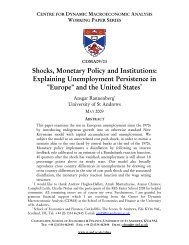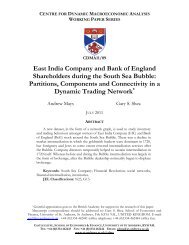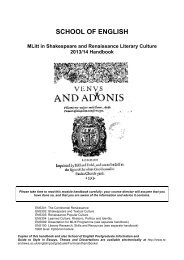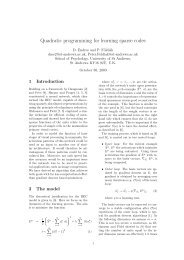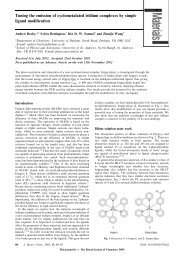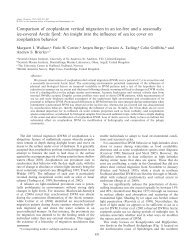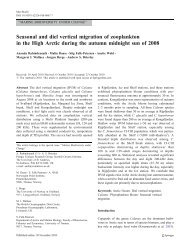Exchange rate dynamics, asset market structure and the role of the ...
Exchange rate dynamics, asset market structure and the role of the ...
Exchange rate dynamics, asset market structure and the role of the ...
Create successful ePaper yourself
Turn your PDF publications into a flip-book with our unique Google optimized e-Paper software.
2.3 Intermediate goods sectors<br />
Firms in <strong>the</strong> intermediate goods sector produce output, y t , that is used in <strong>the</strong> production <strong>of</strong><br />
<strong>the</strong> …nal consumption <strong>and</strong> investment goods at home <strong>and</strong> abroad using capital <strong>and</strong> labour<br />
services employing <strong>the</strong> following constant returns to scale production function:<br />
y t = A t f(k t 1; h t ) (15)<br />
where A t is total factor productivity. The cash ‡ow <strong>of</strong> this typical …rm in <strong>the</strong> intermediate<br />
goods producing sector is:<br />
t = P Ht A t f(k t 1; h t ) P t w t h t P x;t x t (16)<br />
where w t is <strong>the</strong> real wage, P Ht is <strong>the</strong> price <strong>of</strong> home-produced intermediate goods <strong>and</strong> P t<br />
<strong>and</strong> P x;t are <strong>the</strong> consumption <strong>and</strong> investment goods de‡ators, respectively. In this baseline<br />
speci…cation, I assume that home …rms turn home-produced intermediate goods into<br />
capital stock, <strong>and</strong> <strong>the</strong> foreign …rm uses only foreign-produced intermediate goods for investment.<br />
Thus P x;t = P H;t <strong>and</strong> Px;t = PF;t . The …rm faces <strong>the</strong> following capital accumulation<br />
constraint:<br />
k t = (1 )k t 1 + (1 s( x t<br />
x t 1<br />
))x t (17)<br />
where <strong>the</strong> initial capital stock, k 1 , is given, is <strong>the</strong> <strong>rate</strong> <strong>of</strong> depreciation <strong>of</strong> <strong>the</strong> capital stock<br />
<strong>and</strong> (1 s( xt<br />
x t 1<br />
))x t captures investment adjustment costs as proposed by Christiano et al<br />
(2005), i.e. it summarizes <strong>the</strong> technology which transforms current <strong>and</strong> past investment<br />
into installed capital for use in <strong>the</strong> following period. Following Christiano et al, I assume<br />
that <strong>the</strong> function s( xt<br />
x t 1<br />
) has <strong>the</strong> following steady-state properties: s(1) = s 0 (1) = 0 <strong>and</strong><br />
s 00 (1) > 0: Schmitt-Grohé <strong>and</strong> Uribe (2004) suggest <strong>the</strong> following functional form: s( xt<br />
x t 1<br />
) =<br />
<br />
2<br />
<br />
x 2.<br />
t<br />
x t 1<br />
1<br />
For <strong>the</strong> purposes <strong>of</strong> this paper, all that is needed is a value for s 00 (1), which<br />
according to <strong>the</strong> functional form suggested by Schmitt-Grohé <strong>and</strong> Uribe is a constant, : 1<br />
The …rm maximizes shareholder’s value using <strong>the</strong> household’s intertemporal marginal<br />
<strong>rate</strong> <strong>of</strong> substitution as <strong>the</strong> stochastic discount factor. The Lagrangian corresponding to <strong>the</strong><br />
1 It is easy to show that whereas <strong>the</strong> function (1 s(x t =x t 1 ))x t is not concave for all values <strong>of</strong> x, it is so<br />
in <strong>the</strong> vicinity <strong>of</strong> <strong>the</strong> steady state, thus <strong>the</strong> problem is st<strong>and</strong>ard in <strong>the</strong> sense that <strong>the</strong> conditions (19) - (21)<br />
plus <strong>the</strong> constraint <strong>and</strong> <strong>the</strong> relevant terminal conditions are necessary as well as su¢ cient.<br />
8



